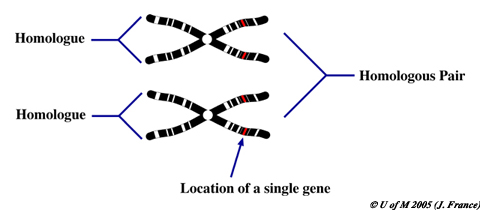
Chromosomes in the nucleus of a cell contain the hereditary units called genes. These units are passed on from generation to generation and are the raw material from which the characteristics of an individual are derived. Although humans have been engaged in breeding domestic animals and plants since prehistoric times, a real understanding of these concepts was first gained during the years 1856-1868. During this time the Austrian monk, Gregor Mendel performed some extraordinary experiments with the common garden pea. The results of these experiments, published in 1866, initiated a whole new science called genetics. For our purposes we will define a gene as the unit of heredity which exists at a certain location (locus) on a chromosome. As you know meiosis provides for the reduction of the chromosome number by half, so that new individuals resulting from fertilization of an egg (23 chromosomes in humans) by a sperm (also 23 chromosomes in humans) has 46 chromosomes, just as the parents did.

One major difference between mitosis and meiosis is that in meiosis homologous chromosomes pair and separate from each other; one member of each pair migrates to each daughter cell after the first division. This is the mechanism which ensures that the chromosome number is reduced. Be sure you know what we mean when we speak of homologous chromosomes. In all cells of your body except the germ cells you have 23 pairs of chromosomes; the members of any particular pair are identical in appearance or "homologous", except for the sex chromosomes (X and Y) in males. Homologous chromosomes have genes for the same trait at the same point along their length. The form of the gene (allele) may differ in one of the homologues.

In animal sexual reproduction one chromosome was contributed by the sperm, and one by the egg within each homologous pair. Through meiosis each gamete will receive one copy of each gene (review lab 6). In most organisms there is usually more than one chromosome per cell (human somatic cells have 46). This separation of the chromosomes during gamete formation is what is termed The Law of Segregation or Mendel's first Law. Evidence of this law is provided and explained by the monohybrid and test cross.
Mendel's Law of Independent Assortment
Law of Independent Assortment states that the inheritance of genes located on a pair of homologous chromosomes is not affected by the simultaneous inheritance of other genes located on other homologous pairs. On the basis of what we know about chromosome behaviour during meiosis we can say that the behaviour of a particular homologous pair does not influence the behaviour of the other homologous pairs. That is, the chromosomes and therefore the genes on the chromosomes assort themselves independently. For instance, during anaphase I of meiosis three homologous pairs can separate in any one of eight (23)different combinations.
First published Sept 95: Modified June 2020
Copyright © Michael Shaw 2019 (Images and Text)
![]() Back
to Lab Index
Back
to Lab Index ![]() Forward
to Next Page
Forward
to Next Page ![]() University
of Manitoba Home
University
of Manitoba Home